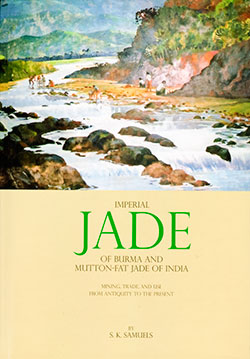Samuels, S.K. (2014) Imperial Jade of Burma and Mutton-Fat Jade of India: Mining, Trade, and Use from Antiquity to the Present. SKS Enterprises, Inc., Tucson, AZ, USA, 248 pp. ISBN: 978-0-9725323-4-1
Jade is a subject that most in the Western world find hard to fathom, in no small part because much of the appreciation of this stone exists in non-Roman (re: Chinese) scripts. Thus a discussion of the finer points of jade connoisseurship by someone unable to read Chinese is not unlike a eunuch’s guide to pillow talk. The thought is nice, but…
While Myanmar (Burma) has been the chief source of fine jadeite for more than two centuries, the Middle Kingdom's history with jade goes back thousands of years and involves far more than jadeite's glassy shine and neon hues. Here's a case in point: as of the time of this writing (May 2014), the most expensive piece of jade ever sold at auction was not jadeite from Myanmar, but nephrite from western China. How's this for another stunner: the color of this "imperial" jade is not green, but white. Perhaps this helps to illuminate just why the Western world considers jade to be "inscrutable."
The current volume has been penned by S.K. Samuels, a Burmese native who has lived in the USA for many decades. Its stated goal is to:
"…correct misconceptions and present a coherent picture of how jade was discovered, mined, and used in Burma over the centuries."
In the book's Preface, the author includes this statement:
"In fact, most of what appears about Burma's jade mines in Western literature to date is not only inaccurate but also incomplete and incorporates unsubstantiated legends. It was written during the colonial and the post-colonial eras and ignores a body of literature that exists in Burmese and English. Then this misinformation has been repeated by more modern writers."
As evidence, Samuels cites the account of Mr. Warry, a British consular officer stationed in China who visited Burma in 1888 with the first expedition of British troops to reach the jade mines. Warry not only spoke Chinese, but in his 7000-word essay gave a detailed description of jade in China, including the nephrite deposits in Xinjiang. In touching on the discovery of jade in Burma, he spends just 200 words relating a story told to him of the discovery of jade in Burma by a Chinese trader in the 13th Century (Hertz, 1912).
Samuels dismisses this tale, but as evidence against it offers only vague statements by authors writing decades later, none of who had actually visited the Burmese jade mines. So whom should one believe, a China expert who visited the source and was [presumably] told of its discovery by someone at the site, or others who never visited the source?
This reviewer has read Warry's essay and finds it entirely believable, reproducing it in his article on the occidental history of jade (Hughes, 1999). Samuels is free to disagree, but he needs to build a better case than what is contained in this book.
It does not help Samuels' case that his book contains provable inaccuracies:
- p. 7: It is stated that the Ruby Mines Ltd. Company was founded in the late 1930s. Actually it was founded in 1934 and closed in 1941.
- p. 139: According to Samuels, by 2001, it was impossible for foreigners to visit either Mogok or Phakant (Hpakan; the jade mines). This reviewer visited both in 2004.
- p. 63: "The Western press wrote about the gem and jade mines from 1885. History prior to this did not seem to matter or was unreliable; apparently, only history after 1885, written by colonial writers, is valid."
Even a casual browsing of the early issues of publications like the Journal of the Asiatic Society of Bengal (founded in 1784) reveal a strong Western curiosity regarding all things Asian; indeed the goal of that society was to study all aspects of the great continent. The first European visitor to the jade mines was in 1837 (Griffith, 1847), while the first eyewitness Western account of the ruby mines was published in 1833 (d'Amato, 1833).
In this text, Samuels repeatedly makes reference to the mistakes of other writers, but includes little in the way of quotations or citations to support his censure. And yet he makes unsubstantiated statements of his own, such as the following:
- P. 51: "In the early years of the tenth century, some Burmese jade was exported privately by traders in small amounts."
No references whatsoever are given to support this claim. While it was certainly not his intention, such passages leave Samuels open to the charge that, while accusing others of hearsay, he is peddling a stone of similar nature.
A full chapter is devoted to the gem material maw sit sit, but the name Eduard Gübelin does not appear at all. While this reviewer appreciates that maw sit sit had been mined for centuries and was mentioned by H.L. Chhibber in 1934, it was Gübelin's publications that put maw sit sit on the world gemological map. Not to mention them is a significant omission in a book that claims to be an attempt to set the jade record straight.
But this is not to say that the book is entirely negative. There is much within its pages that will both thrill and enlighten. I was particularly impressed by the author's wonderful accounts of Chinese nephrite brought to India for working by the subcontinents' expert lapidaries during the Mughal period.
This volume has been privately published, but could have benefited greatly from a professional editor and comprehensive fact checking, as the following examples show:
- The index omits important places like Mogok, even though it is mentioned in several places in the text.
- While the book contains 163 photos, maps and diagrams, many are of poor quality and/or reproduced too small to be effective. In certain cases, outside illustrations do not appear to be properly credited.
- Citations appear in footnotes at the bottom of the relevant pages, but with little consistency in style, some missing pertinent information like the date and even name of publication.
Scholars (and this reviewer in particular) would welcome a comprehensive English-language volume on the history of Burmese jade, particularly one written by someone fluent in Burmese who could provide insights that only a native speaker might glean. Unfortunately the current book falls short. The thought is nice, but…
As a fellow author, I appreciate the amount of work that goes into producing a book of this type, and as someone who has self-published, I also understand the pitfalls. It is my sincere hope that the author will consider preparing a second, corrected edition. If done properly, it has the potential to become a valuable addition to the world gemological literature.

References
- d’Amato, P.G. (1833) A short description of the mines of precious stones in the district of Kyatpyin, in the Kingdom of Ava. Journal of the Asiatic Society of Bengal, Vol. 2, pp. 75–76.
- Griffith, W. (1847) Journals of Travels in Assam, Burma, Bootan, Affghanistan, and the Neighbouring Countries. Calcutta, Bishop’s College Press, 529 pp.
- Hertz, W.A. (1912) Burma Gazetteer: Myitkyina District. Rangoon, Superintendent, Govt. Printing and Staty., Volume A, reprinted 1960, 193 pp., map.
- Hughes, R.W. (1999) Burma’s jade mines: An annotated Occidental history. Journal of the Geo-Literary Society, Vol. 14, No. 1, January, pp. 15–35.
Notes
First posted online in Gems & Gemology on 19 May, 2015. Review submitted 23 May 2014.

